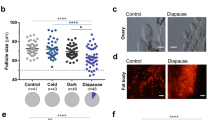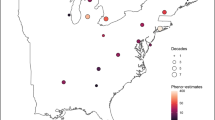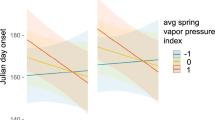Abstract
IN temperate latitudes, many arthropods rely on photoperiod to cue their seasonal development. Although the relationship between critical photoperiod and latitude is well illustrated, that between critical photoperiod and altitude remains obscure1,2. I wish to consider photoperiodic control of dormancy in the pitcher-plant mosquito, Wyeomyia smithii, and quantify the relative effects of altitude and latitude on the photoperiodic response of an organism.
This is a preview of subscription content, access via your institution
Access options
Subscribe to this journal
Receive 51 print issues and online access
$199.00 per year
only $3.90 per issue
Buy this article
- Purchase on Springer Link
- Instant access to full article PDF
Prices may be subject to local taxes which are calculated during checkout
Similar content being viewed by others
References
Danilevskii, A. S., Photoperiodism and Seasonal Development of Insects (Oliver and Boyd, Edinburgh, 1965).
Danilevskii, A. S., Goryshin, N. I., and Tyshchenko, V. P., A. Rev. Ent., 15, 201–244 (1970).
Burgess, I., and Rempel, J. G., Can. Ent., 103, 886–887 (1971).
Dodge, H. R., Proc. Entomol. Soc. Wash., 49, 117–122 (1947).
Carpenter, S. J., and LaCasse, W. J., Mosquitoes of North America (University of California Press, Berkeley, 1955).
Haufe, W. O., Can. Ent., 84, 254–263 (1952).
Bradshaw, W. E., and Lounibos, L. P., Can. J. Zool., 50, 713–719 (1972).
Smith, S. M., and Brust, R. A., Can. J. Zool., 49, 1065–1073 (1971).
Beck, S. D., Insect Photoperiodism (Academic, New York, 1968).
Lees, A. D., The Physiology of Diapause in Arthropods (University Press, Cambridge, 1955).
Bradshaw, W. E., Biol. Bull., 146, 11–19 (1974).
Tauber, M. J., and Tauber, C. A., Nature, 258, 711–712 (1975).
Lounibos, L. P., and Bradshaw, W. E., Can. J. Zool., 53, 215–221 (1975).
Climatic Atlas of the United States (US Department of Commerce, Washington DC, 1968).
Haufe, W. O., and Burgess, L., Ecology, 37, 500–519.
Ruibal, R., Copeia, 212–221 (1957).
Johnston, R. F., Condor, 56, 268–273 (1954).
Lord, R. D., Am. Midl. Nat., 64, 488–499 (1960).
Hardwick, D. F., and Lefkovitch, L. P., Can. Ent., 103, 1217–1235 (1971).
Snyder, G. K., and Weathers, W. W., Am. Nat., 109, 93–101 (1975).
Masaki, S., Evolution, 26, 587–600 (1972).
Petersen, B., Zool. Bidr. Uppsala, 26, 329–531 (1947).
Hopkins, A. D., US Dept Agric. Misc. Publ., 280, 1–188 (1938).
Tables of Sunrise, Sunset, and Twilight (Nautical Almanac Office, US Naval Observatory, Washington, DC, 1962).
Author information
Authors and Affiliations
Rights and permissions
About this article
Cite this article
BRADSHAW, W. Geography of photoperiodic response in diapausing mosquito. Nature 262, 384–386 (1976). https://doi.org/10.1038/262384b0
Received:
Accepted:
Published:
Issue Date:
DOI: https://doi.org/10.1038/262384b0
This article is cited by
-
Clock-talk: have we forgotten about geographic variation?
Journal of Comparative Physiology A (2023)
-
Semi-field and surveillance data define the natural diapause timeline for Culex pipiens across the United States
Communications Biology (2022)
-
Modelling diapause in mosquito population growth
Journal of Mathematical Biology (2019)
-
Differences in life-cycle traits of Calanus finmarchicus originating from 60°N and 69°N, when reared in mesocosms at 69°N
Marine Biology (2003)
-
Strong habitat selection and the development of population structure in a mosquito
Evolutionary Ecology (1987)
Comments
By submitting a comment you agree to abide by our Terms and Community Guidelines. If you find something abusive or that does not comply with our terms or guidelines please flag it as inappropriate.



